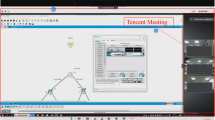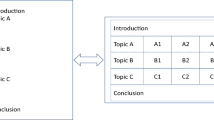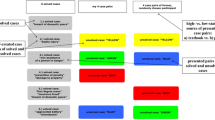Abstract
This experimental investigation seeks to confirm and extend previous investigations that resource interdependence vs. independence during problem-solving relatively extends the problem representation phase before convergence on a solution. In this current investigation, ninth-grade Korean native language participants (n = 240) worked online to complete either a well-structured or an ill-structured problem in either independent triads where all of the members were provided with all of the information needed to solve the problem, or in interdependent triads where members were each provided with different portions of the information needed. The discussions were analyzed using a content analysis rubric from Engelmann and Hesse (JAMA 5:299–319, 2010), and knowledge structures were elicited as concept maps and essays and then analyzed using a graph-theoretic psychometric network scaling approach. Analysis of transcripts of the triad interactions showed a similar pattern of divergence and then convergence for the well-structured and the ill-structured problems that confirmed the previous investigations. As anticipated, interdependent triads performed relatively better on the ill-structured problem perhaps due to the extended divergence phase, while independent triads were better on the well-structured problem perhaps due to a rapid transition to the convergence phase. Knowledge structure analysis of group maps shows that the interdependent triad maps resembled the fully explicated problem space, while the independent triad maps most resembled the narrow problem solution space. Suggestions for practice include first increasing students’ awareness of divergent and convergent thinking, allowing enough time for the activity, and also requiring teams to submit a problem space artifact before working on a solution. Such skills are a basis for learning in school, but more importantly, will prepare students for a world where change is a constant and learning never stops.





Similar content being viewed by others
References
Asino, T., Clariana, R. B., Dong, Y., Groff, B., Ntshalintshali, G., Taricani, E., Techatassanasoontorn, C., & Yu, W. (2012). The effect of Independent and Interdependent Group collaboration on knowledge extent, knowledge form and knowledge convergence. convergence. Proceedings of Selected Research and Development Papers Presented at the National Convention of the Association for Educational Communications and Technology, 35, 20–29 (Louisville, November 2012).
Barb, A. S., & Clariana, R. B. (2013). Applications of PathFinder Network scaling for improving the ranking of satellite images. IEEE Journal of Selected Topics in Applied Earth Observations and Remote Sensing, 6(3), 1092–1099. https://doi.org/10.1109/JSTARS.2013.2242254
Barber, S. J., Harris, C. B., & Rajaram, S. (2015). Why two heads apart are better than two heads together: Multiple mechanisms underlie the collaborative inhibition effect in memory. Journal of Experimental Psychology: Learning, Memory, and Cognition, 41(2), 559.
Biasutti, M., & Frate, S. (2018). Group metacognition in online collaborative learning: Validity and reliability of the group metacognition scale (GMS). Educational Technology Research and Development, 66(6), 1321–1338.
Buchs, C., Dumesnil, A., Chanal, J., & Butera, F. (2021). Dual effects of partner’s competence: Resource interdependence in cooperative learning at elementary school. Education Sciences, 11, 210–226. https://doi.org/10.3390/educsci11050210
Churchman, C. W. (1967). Wicked problems. Management Science, 14, 141–146.
Clariana, R. B., Engelmann, T., & Yu, W. (2013). Using centrality of concept maps as a measure of problem space states in computer-supported collaborative problem solving. Educational Technology Research and Development, 61(3), 423–442. https://doi.org/10.1007/s11423-013-9293-6
Clariana, R. B., Wolfe, M. B., & Kim, K. (2014). The influence of narrative and expository lesson text structures on knowledge structures: Alternate measures of knowledge structure. Educational Technology Research and Development, 62(5), 601–616. https://doi.org/10.1007/s11423-014-9348-3
Congleton, A. R., & Rajaram, S. (2011). The influence of learning methods on collaboration: Prior repeated retrieval enhances retrieval organization, abolished collaborative inhibition, and promotes post-collaborative memory. Journal of Experimental Psychology: General, 140, 535–551. https://doi.org/10.1037/a0024308
Coronges, K. A., Stacy, A. W., & Valente, T. W. (2007). Structural comparison of cognitive associative networks in two populations. Journal of Applied Social Psychology, 37(9), 2097–2129. https://doi.org/10.1111/j.1559-1816.2007.00253.x
Cropley, A. (2006). In praise of convergent thinking. Creativity Research Journal, 18, 391–404. https://doi.org/10.1207/s15326934crj1803_13
Cukurova, M., Luckin, R., Millán, E., & Mavrikis, M. (2018). The NISPI framework: Analysing collaborative problem-solving from students' physical interactions. Computers & Education, 116, 93-109.
Daniel, T. (2015). Developing and sustaining high-performance work teams. Retrieved November, 30, 2015.
Draper, D. C. (2013). The instructional effects of knowledge-based community of practice learning environment on student achievement and knowledge convergence. Performance Improvement Quarterly, 25(4), 67–89. https://doi.org/10.1002/piq.21132
Engelmann, T., & Hesse, F. W. (2010). How digital concept maps about the collaborators’ knowledge and information influence computer-supported collaborative problem solving. International Journal of Computer-Supported Collaborative Learning, 5(3), 299–319.
Engelmann, T., Kozlov, M. D., Kolodziej, R., & Clariana, R. B. (2014). Computers in Human Behavior Fostering group norm development and orientation while creating awareness contents for improving net-based collaborative problem solving. Computers in Human Behavior, 37, 298–306. https://doi.org/10.1016/j.chb.2014.04.052
English, D., & Branaghan, R. (2012). An empirically derived taxonomy of pilot violation behavior. Safety Science. http://www.sciencedirect.com/science/article/pii/S0925753511001809
Fesel, S. S., Segers, E., Clariana, R. B., & Verhoeven, L. (2015). Quality of children’s knowledge representations in digital text comprehension: Evidence from pathfinder networks. Computers in Human Behavior, 48, 135–146. https://doi.org/10.1016/j.chb.2015.01.014
Graesser, A. C., Greiff, S., Stadler, M., & Shubeck, K. T. (2020). Collaboration in the 21st century: The theory, assessment, and teaching of collaborative problem solving. Computers in Human Behavior.
Guilford, J. P. (1959). Traits of creativity. In H. H. Anderson (Ed.), Creativity and its Cultivation (pp. 142–161). Harper.
Hung, W., Dolmans, D. H. J. M., & Van Merriënboer, J. J. G. (2019). A review to identify key perspectives in PBL meta-analyses and reviews: Trends, gaps and future research directions. Advances in Health Sciences Education, 24(5), 943–957.
Jaarsveld, S., & Lachmann, T. (2017). Intelligence and creativity in problem solving: The importance of test features in cognition research. Frontiers in Psychology, 8, 134–145.
Jacobson, M. J. (1991). Knowledge acquisition, cognitive flexibility, and the instructional applications of hypertext: A comparison of contrasting designs for computer-enhanced learning environments. University of Illinois at Urbana-Champaign.
Jonassen, D. H. (1997). Instructional design models for well-structured and III-structured problem-solving learning outcomes. Educational Technology Research and Development, 45(1), 65–94.
Jonassen, D. H. (2010). Research issues in problem solving. 11th International Conference on Education Research.
Kim, K., & Clariana, R. B. (2015). Knowledge structure measures of reader’s situation models across languages: Translation engenders richer structure. Technology, Knowledge and Learning, 20(2), 249–268.
Kim, K. (2017a). Visualizing first and second language interactions in science reading: A knowledge structure network approach. Language Assessment Quarterly, 14, 328–345.
Kim, K. (2017b). Graphical interface of knowledge structure: A web-based research tool for representing knowledge structure in text. Technology Knowledge and Learning, 24, 89–95.
Kim, K., Clarianay, R. B., & Kim, Y. (2019). Automatic representation of knowledge structure: Enhancing learning through knowledge structure reflection in an online course. Educational Technology Research and Development, 67, 105–122.
Kim, K., & Tawfik, A. A. (2021). Different approaches to collaborative problem solving between successful versus less successful problem solvers: Tracking changes of knowledge structure. Journal of Research on Technology in Education, https://doi.org/10.1080/15391523.2021.2014374
Kim, M. K. (2012). Cross-validation study of methods and technologies to assess mental models in a complex problem solving situation. Computers in Human Behavior, 28(2), 703–717. https://doi.org/10.1016/j.chb.2011.11.018
Kim, M. K., & McCarthy, K. S. (2021). Using graph centrality as a global index to assess students’ mental model structure development during summary writing. Educational Technology Research and Development, 69(2), 971–1002.
Laal, M. (2013). Positive interdependence in collaborative learning. Procedia-Social and Behavioral Sciences, 93, 1433–1437.
Lu, L., Yuan, Y. C., & McLeod, P. L. (2012). Twenty-five years of hidden profiles in group decision making: A meta-analysis. Personality and Social Psychology Review, 16(1), 54–75.
Maker, C. J. (2020). Identifying exceptional talent in science, technology, engineering, and mathematics: Increasing diversity and assessing creative problem-solving. Journal of Advanced Academics, 31(3), 161–210.
Marion, S. B., & Thorley, C. (2016). A meta-analytic review of collaborative inhibition and postcollaborative memory: Testing the predictions of the retrieval strategy disruption hypothesis. Psychological Bulletin, 142(11), 1141.
Matthews, R. S., Cooper, J. L., Davidson, N., & Hawkes, P. (1995). Building bridges between cooperative and collaborative learning. Change: the Magazine of Higher Learning, 27(4), 35–40. https://doi.org/10.1080/00091383.1995.9936435
McLeod,, C. (2015). Trust. In E. N. Zalta (Ed.). The Stanford encyclopedia of philosophy (Fall 2015 Edition). https://plato.stanford.edu/archives/fall2015/entries/trust/
Nokes-Malach, T. J., Richey, J. E., & Gadgil, S. (2015). When is it better to learn together? Insights from research on collaborative learning. Educational Psychology Review, 27(4), 645–656.
O’Donnell, A. M., & Hmelo-Silver, C. E. (2013). Introduction: What is collaborative learning?: An overview. In The International Handbook of Collaborative Learning (pp. 1–15). Taylor and Francis. https://doi.org/10.4324/9780203837290-6
Patil, K., & Brazdil, P. (2007). Text summarization: Using centrality in the pathfinder network. International Journal of Computer Science & Information Systems, 2, 18–32.
Popper, K. (2013). All life is problem solivng. Routledge.
Reed, S. K. (2016). The structure of ill-structured (and well-structured) problems revisited. Educational Psychology Review, 28(4), 691–716.
Reiser, B. J. (2015). Scaffolding complex learning: The mechanisms of structuring and problematizing student work. The Journal of the Learning Sciences, 13(3), 273–304.
Sarwar, G. (2011). Structural assessment of knowledge for misconceptions: Effectiveness of structural feedback provided by pathfinder networks in the domain of physics. Kolln, Germany: LAP Lambert Academic Publishing. https://scholar.google.com/scholar?q=Structural+assessment+of+knowledge+for+misconceptions%3A+Effectiveness+of+structural+feedback+provided+by+pathfinder+networks+in+the+domain+of+physics&btnG=&hl=en&as_sdt=0%2C39#0
Shin, N., Jonassen, D. H., & McGee, S. (2003). Predictors of well-structured and ill-structured problem solving in an astronomy simulation. Journal of Research in Science Teaching, 40(1), 6–33.
Stasser, G., & Titus, W. (1985). Pooling of unshared information in group decision making: Biased information sampling during discussion. Journal of Personality and Social Psychology, 48(6), 1467.
Tossell, C., Schvaneveldt, R., & Branaghan, R. (2010). RESEARCH ARTICLES-targeting knowledge structures: A new method to elicit the relatedness of concepts. Cognitive Technology, 15(2), 11.
Trumpower, D. L., & Sarwar, G. S. (2010). Effectiveness of structural feedback provided by pathfinder networks. Journal of Educational Computing Research, 43(1), 7–24. https://doi.org/10.2190/EC.43.1.b
Trumpower, D. L., Sharara, H., & Goldsmith, T. E. (2010). Specificity of structural assessment of knowledge. Journal of Technology, Learning, and Assessment, 8(5), n5.
Tutty, J. I., & Klein, J. D. (2008). Computer-mediated instruction: A comparison of online and face-to-face collaboration. Educational Technology Research and Development, 56(2), 101–124.
Yoo, S. (2020). The effects of expertise diversity and task interdependence on project team effectiveness: The moderating role of individual autonomy [Doctoral dissertation, University of Minnesota]. University Digital Conservancy Home persistent link https://hdl.handle.net/11299/216356.
Funding
National Science Foundation Award 2215807, PI: Roy B. Clariana.
Author information
Authors and Affiliations
Corresponding author
Ethics declarations
Conflict of interest
The authors declare that they have no conflict of interest.
Additional information
Publisher's Note
Springer Nature remains neutral with regard to jurisdictional claims in published maps and institutional affiliations.
Rights and permissions
Springer Nature or its licensor (e.g. a society or other partner) holds exclusive rights to this article under a publishing agreement with the author(s) or other rightsholder(s); author self-archiving of the accepted manuscript version of this article is solely governed by the terms of such publishing agreement and applicable law.
About this article
Cite this article
Kim, K., Clariana, R.B. The influence of resource interdependence during problem solving in groups: tracking changes in knowledge structure. Education Tech Research Dev 71, 833–857 (2023). https://doi.org/10.1007/s11423-023-10206-3
Accepted:
Published:
Issue Date:
DOI: https://doi.org/10.1007/s11423-023-10206-3




